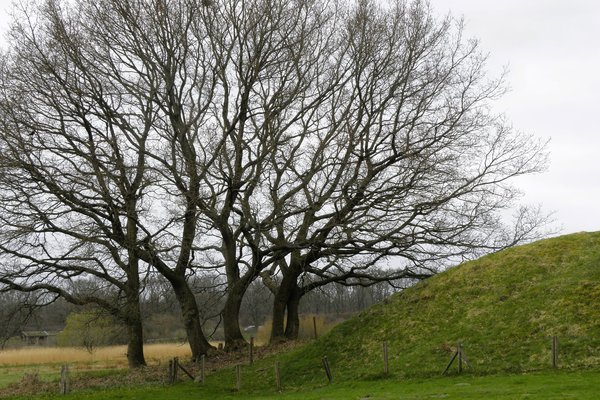Germany
Hedeby and Danevirke
The Archaeological Border Complex of Hedeby and the Danevirke comprises the archeological site of a medieval trading network that existed between Western and Northern Europe.
The Danevirke was a 33km long fortified wall that marked the border between the emerging Danish kingdom and the Frankish Empire. Hedeby was a market town that expanded due to the growing economic power of the Danish Vikings.
Community Perspective: the Viking Museum at Haithabu provides the most comprehensive overview, although its structures are mostly reconstructions, as not much of the originals are left beyond the earthworks. Nan provides a local perspective, and Clyde describes a full visit, including the Dannewerk museum.
Site Info
Official Information
- Full Name
- Archaeological Border Complex of Hedeby and the Danevirke (ID: 1553)
- Country
- Germany
- Status
-
Inscribed 2018
Site history
History of Hedeby and Danevirke
- 2018: Inscribed
- Inscribed
- 2015: Deferred
- Type
- Cultural
- Criteria
- iii
- iv
Links
- UNESCO
- whc.unesco.org
- Official
-
- schloss-gottorf.de — Viking Museum Haithaby (Hedeby)
- danevirkemuseum.de — Danewerk Museum
- Related
-
- de.wikipedia.org — Danewerk on the German Wikipedia
- spiegel.de — Danewerk: Archäologen finden das Tor zum Wikingerreich
All Links
UNESCO.org
- whc.unesco.org — whc.unesco.org/
Official Website
- schloss-gottorf.de — Viking Museum Haithaby (Hedeby)
- danevirkemuseum.de — Danewerk Museum
Related Resources
- de.wikipedia.org — Danewerk on the German Wikipedia
- spiegel.de — Danewerk: Archäologen finden das Tor zum Wikingerreich
News Article
- April 5, 2018 sueddeutsche.de — Viking Museum Hedeby to reopen May 2018
- March 3, 2018 ndr.de — Great archaeological findings in Haithabu
Community Information
- Community Category
- Archaeological site: Viking
Travel Information
Hamburg Hotspot
Recent Connections
-
Hamburg Hotspot
Haithabu lies 128km (1h45 by car) from … -
Petrosomatoglyphs
In September 2020, a brick stone was fo… -
Underwater Archaeology
Location 1553-019 "Offshore Work"
Connections of Hedeby and Danevirke
- Geography
- Trivia
-
-
Minority communities
Danish minority of Southern SchleswigSee en.wikipedia.org
-
- Damaged
-
-
Destroyed during invasion
Hedeby was destroyed by the Slavs in 1066.
-
- Human Activity
-
-
Cremation
About 6% of the people in the grave fields were cremated (nom file) -
Sea Ports
Hedeby: port at the inlet of the Schlei -
Viking settlements
Hedeby is a Viking era trading settlement. -
Forced labour during WWII
Right after WWII German prisoners were forced to work at the reconstruction of Dannewirke by the British -
Petrosomatoglyphs
In September 2020, a brick stone was found with a small footprint. It is on display in the Danevirke museum. -
Textiles
The numerous pit houses in Hedeby probably served to process textiles during summer. -
Writing systems
Runic script on the Hedeby stonesSee en.wikipedia.org
-
- Constructions
-
-
Cemeteries
Hedeby: large Viking Age cemetery (South Cemetery), also a ship burial and a barrow cemetery with cremation burials (nom file) -
Frontier walls
Danevirke - between the Danish kingdom and the Frankish empire -
Tombs
Hedeby: ten elaborate chambered tombs (nom file)
-
- Timeline
-
-
Built in the 8th century
The first stage of monumental construction at the Dannewirke dates to 700 (Phase III)
-
- WHS Hotspots
-
-
Hamburg Hotspot
Haithabu lies 128km (1h45 by car) from Hamburg
-
- Science and Technology
-
-
Archaeological potential
Some 95% of the town remains unexcavated (AB ev) -
Experimental Archaeology
Viking housesSee www.pallia.net
-
Underwater Archaeology
Location 1553-019 "Offshore Work"
-
News
- sueddeutsche.de 04/05/2018
- Viking Museum Hedeby to reopen May…
- ndr.de 03/03/2018
- Great archaeological findings in H…
Recent Visitors
Visitors of Hedeby and Danevirke
- Adrian Turtschi
- Alexander Lehmann
- Ammon Watkins
- Ana Lozano
- Anna Wludarska
- Argo
- ArnaudFilloux
- Ask Gudmundsen
- Assif
- Astraftis
- Atila Ege
- Axel Hansson
- BaziFettehenne
- Bin
- Bodil Ankerly
- Can SARICA
- Caspar
- chenqtao
- Chole Ross
- christof
- Christoph
- Christravelblog
- Claire Bradshaw
- Clyde
- Cobaltrage
- Colossus
- Csaba Nováczky
- CugelVance
- Dagmara
- Daniel Chazad
- Dan Pettigrew
- Dimitar Krastev
- Dirk-pieter
- Echwel
- Elia Vettorato
- Ellen Nielsen
- Els Slots
- erdsaumnaht
- Erik Jelinek
- Errol Neo
- Eva Kisgyorgy
- Evgenii
- Farinelli
- Feldhase
- Femke Roos
- Filip Murlak
- FK
- Flexiear
- Frederik Dawson
- FS
- George Gdanski
- Grendel Gongan
- Harald T.
- Harry Mitsidis
- heywhatever2
- Hubert
- Iain Jackson
- Ingemar Eriksson
- Ivan Rucek
- Jakob F.
- Janina Lehmann
- Janos
- Jan-Willem
- Jan Zimmermann
- Jarek Pokrzywnicki
- Jasam
- Jean Lecaillon
- Jesse S 2010
- Jezza
- John Smaranda
- Jonas Hagung
- Jonas Kremer
- Jonas Martinsson
- Karito Vies
- Kasia M.
- Kbecq
- Knut
- Kristin
- Kurt Lauer
- Lisu Marian
- Luboang
- Luis Filipe Gaspar
- Maciej Gil
- Manuelfunk
- Martina Rúčková
- MaYumin
- Michaela0705
- Mikko
- Mikko Syrjä
- Miloš Tašković
- nan
- Nasebaer
- Nicole Lampos
- Nihal Ege
- Patrik
- Paul Schofield
- PeterH
- Peter Lööv
- Philipp Peterer
- Rachel Perkins
- Ralf Regele
- Randi Thomsen
- Reza
- Roger Ourset
- Roman Bruehwiler
- Roman Raab
- Ronbon
- Rudegirl
- Sabrina Liebehentschel
- Sandmann15
- Sandra!
- Sebasfhb
- serghei.belous
- Simonh
- SirLoydd
- Solivagant
- Stanislaw Warwas
- Stijn
- Svein Elias
- Taotao Chen
- Tatiana Nikulnikova
- Thomas Buechler
- Thomas van der Walt
- Thorben
- Timonator
- Tsunami
- usagi1974
- Valentina
- VLabhard
- WalGra
- Wojciech Fedoruk
- YaroMir
- Yevhen Ivanovych
- Zoë Sheng
- Zos M
Community Reviews
Show full reviews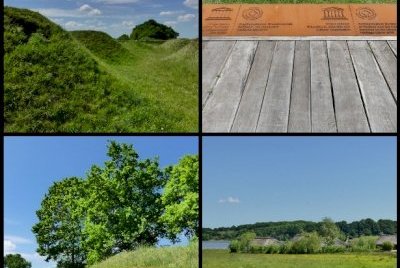
I visited this WHS in May 2020 as a long road trip after two months of lockdown. I visited both inscribed main locations starting with a visit just outside the town of Dannewerk (or Dannevirke) and then heading to Haithabu (or Hedeby).
Make sure to follow the brown sign to Dannewerk Museum not the yellow one to Dannewerk town. I parked for free near the small museum. It is possible to visit the 22 inscribed locations between Dannewerk and Haithabu completely free of charge and as such these are open 24/7. The small Dannewerk museum entrance costs 5 euros while the bigger Haithabu Viking Museum costs 8 euros to visit.
As is the case with all Viking Age sites, there isn't much to see apart from the ubiquitous earthwork mounds and ramparts as wood isn't a durable medium. That said, and after heeding Nan's advice not to expect much of this WHS, I still was positively surprised by the scale of the curved walls near Dannewerk, stretching for around 30 km and connecting Dannewerk and Haithabu between the Baltic Sea and the North Sea.
Dannewerk is a fortification constructed by the Danes in the Early to High Middle Ages to protect themselves against peoples from the South. It is an archaeological and cultural monument of European significance with elements of a historical cultural landscape which have almost disappeared elsewhere. A brick section of the 12th century curved walls concealed beneath the earth, grass and oak trees can …
Keep reading 0 comments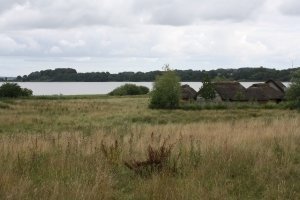
July 2019 - on our trip from Hamburg to Denmark we had to stop here for sure. Another German WHS, eventually we want to visit them all. My father told me about his classtrip he did there in the 60th. It was already then a famous site. However, all there is, are some reconstructed moviesetting like huts, a giant grassed dike and many sheep. For us the most interesting part. Museum, souvenirs and the small wooden huts did not interest us that much so we did not bother to pay the rather high entrance fees.
Nice stop, because of the surroundings but if you are not interested in Viking age, than its no highlite visiting WHS.
Keep reading 0 comments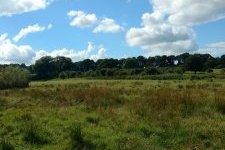
Being born and raised in Schleswig Holstein, the Northern most state of Germany, I was made to visit Haithabu already at a young age. It features prominently in the local history lessons and we were taken there in elementary school as a school trip. My main memory was that it was fairly mundane: a big earthen circle and grass meadows. The reason the site is featured so heavily in the curriculum of local schools is that there actually is very little else of "early" history in Schleswig Holstein.
Haithabu lay on the borders of the Holy Roman Empire of Charlemagne. Being strategically located on the Schlei, a bay on the Baltic Sea, it functioned as a major trade hub between the Holy Roman Empire and Northern Europe. For a time it was probably the largest urban settlement in Northern Europe, albeit that doesn't mean much. It is assumed up to 2000 people lived in Haithabu at it's peak. To put that into perspective, Cologne had 15.000 inhabitants, let alone Constantinople with at least 100.000.
The most interesting story I remember from my history lessons in elementary school is that the vikings sailed the Schlei westward where they would land their ships and transport goods and ships via land for 18km to reach a tributary to the Eider river. Via the Eider they were able to reach the North Sea. This way they saved themselves the long and dangerous voyage around the Skagerak. Nowadays the sources are not …
Keep reading 0 comments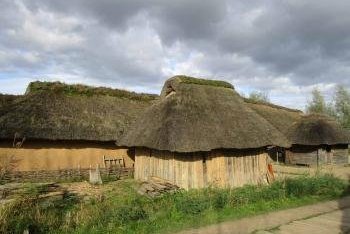
Some man involved in nominating this site for Germany came over to speak in my class during Winter Semester 2015-16 when I was still enrolled in the master's degree program "World Heritage Studies" in Germany and said that they had given up nominating this site as a transnational serial site with 4 other state parties and had decided to go alone at it; thus another nomination called "Hedeby and Danevirke, an archaeological border landscape."
I took a Flix bus from Hamburg, which dropped me off at some gas station in Schleswig about 3 km away from the outdoor museum area. But luckily within a few minutes I found an elderly woman who lives in Busdorf near the museum and who gave me a ride to the museum area.
I had seen this kind of reconstructed Viking houses in Lofoten Islands in Norway, Birka in Sweden and Trelleborg in Denmark.
So I guess it may be a good idea to distinguish itself by presenting this area with such a different view point as archaeological border landscape with the remains of the earthwork.
Keep reading 0 comments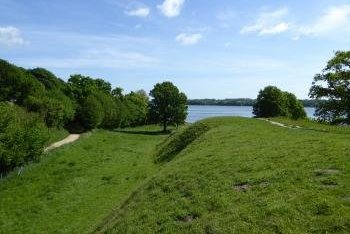
I visited the Hedeby site, which is well developed for tourists, with a museum (closed at the moment for refurbishment), walking pathes and reconstructed houses. Hedeby (or Haithabu in German) was a well-sized city at the edge of the viking lands. As with other viking sites (like Birka or Trelleborg) the problem is that almost everything was built out of wood, so there is not much left of it but the earthworks. In the case of Hedeby, the earthen city walls are still standing (and walkable), but most of the area inside is empty. There are some quite nice reconstructions of viking houses, which will be the most interesting thing for most visitors. There are also demonstrations, market stalls and exhibition houses, so there is more to do than to stare at mounds. Also interesting is the visitable archaeological dig, although most finds seemed to be small things like nails or bone remains. The whole area is rather idyllic, with a nice lake and an undisturbed environment. It is a good place for hiking. As there are no nearby settlements today, getting there can be a problem. It is rather easy with a car, as the main highway from the north (e.g. to Jelling) to the south (e.g. to Hamburg) is quite close, but public transport might be difficult.
All in all, I had a very pleasant visit there, and really got a good impression of how they lived in the viking times. However, the most interesting things are reconstructions …
Keep reading 0 comments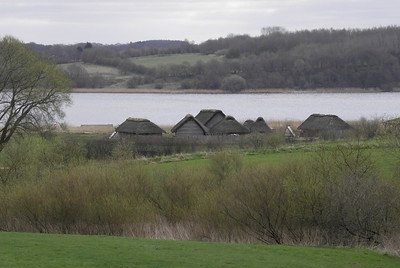
I visited Danevirk and Hedeby on my way to the WHS of Jelling. There are several places where one can see the remains of the Danevirk (or Dannewerk in German), but the Viking Museum at Haithabu probably is the most worthwhile.
The Danevirk was the Viking's equivalent to Hadrian's Wall: built to keep out the barbarians. It covered a stretch of 30km in what is now the German state of Schleswig-Holstein (formerly in Denmark). Hedeby / Haithabu was the most important town in the region. It was located along the shortcut route between North Sea and Baltic Sea.
The Viking Museum at Haithabu has a modern presentation inside, though as so often there has not been found much of real interest from the Viking area. A lot of people seemed to have lost their money bag while getting on or off-board in the harbour!
The museum has a large outdoor part too. It holds a recreation of Haithabu in its original location, a part of the Dannewerk and the semicircular defensive walls of Haithabu itself. It's a great area for a longer hike: you can either walk on top of the Dannewerk, or do a full loop around the lake.
Keep reading 0 comments
